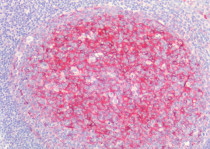ARG63834
anti-ApoJ / Clusterin antibody
anti-ApoJ / Clusterin antibody for ICC/IF,IHC-Formalin-fixed paraffin-embedded sections,Western blot and Human
Cancer antibody; Cell Biology and Cellular Response antibody; Immune System antibody; Metabolism antibody; Signaling Transduction antibody
Overview
| Product Description | Goat Polyclonal antibody recognizes ApoJ / Clusterin |
|---|---|
| Tested Reactivity | Hu |
| Predict Reactivity | Dog |
| Tested Application | ICC/IF, IHC-P, WB |
| Specificity | This antibody is expected to recognise both reported isoforms (NP_001822.2 and NP_976084.1) |
| Host | Goat |
| Clonality | Polyclonal |
| Isotype | IgG |
| Target Name | ApoJ / Clusterin |
| Antigen Species | Human |
| Immunogen | C-EKALQEYRKKHREE |
| Conjugation | Un-conjugated |
| Alternate Names | Clusterin; Apolipoprotein J; SGP-2; SP-40; APOJ; ApoJbeta; CLU2; CLU1; NA1/NA2; TRPM2; CLI; SGP2; Apo-J; TRPM-2; ApoJalpha; Aging-associated gene 4 protein; APO-J; Complement cytolysis inhibitor a chain; Ku70-binding protein 1; Complement cytolysis inhibitor b chain; Testosterone-repressed prostate message 2; Complement-associated protein SP-40,40; KUB1; AAG4; Complement cytolysis inhibitor |
Application Instructions
| Application Suggestion |
|
||||||||
|---|---|---|---|---|---|---|---|---|---|
| Application Note | WB: Recommend incubate at RT for 1h. IHC-P: Antigen Retrieval: Steam tissue section in Citrate buffer (pH 6.0). * The dilutions indicate recommended starting dilutions and the optimal dilutions or concentrations should be determined by the scientist. |
||||||||
| Positive Control | Human colon | ||||||||
| Observed Size | ~ 37 kDa |
Properties
| Form | Liquid |
|---|---|
| Purification | Purified from goat serum by antigen affinity chromatography. |
| Buffer | Tris saline (pH 7.3), 0.02% Sodium azide and 0.5% BSA. |
| Preservative | 0.02% Sodium azide |
| Stabilizer | 0.5% BSA |
| Concentration | 0.5 mg/ml |
| Storage Instruction | For continuous use, store undiluted antibody at 2-8°C for up to a week. For long-term storage, aliquot and store at -20°C or below. Storage in frost free freezers is not recommended. Avoid repeated freeze/thaw cycles. Suggest spin the vial prior to opening. The antibody solution should be gently mixed before use. |
| Note | For laboratory research only, not for drug, diagnostic or other use. |
Bioinformation
| Database Links | |
|---|---|
| Background | The protein encoded by this gene is a secreted chaperone that can under some stress conditions also be found in the cell cytosol. It has been suggested to be involved in several basic biological events such as cell death, tumor progression, and neurodegenerative disorders. Alternate splicing results in both coding and non-coding variants.[provided by RefSeq, May 2011] |
| Research Area | Cancer antibody; Cell Biology and Cellular Response antibody; Immune System antibody; Metabolism antibody; Signaling Transduction antibody |
| Calculated MW | 52 kDa |
| PTM | Isoform 1 is proteolytically cleaved on its way through the secretory system, probably within the Golgi lumen. Polyubiquitinated, leading to proteasomal degradation. Heavily N-glycosylated. About 30% of the protein mass is comprised of complex N-linked carbohydrate. |
Images (3) Click the Picture to Zoom In
-
ARG63834 anti-ApoJ / Clusterin antibody ICC/IF image
Immunofluorescence: Paraformaldehyde-fixed HeLa cells permeabilized with 0.15% Triton. Cells were stained with ARG63834 anti-ApoJ / Clusterin antibody (green) at 10 µg/ml for 1 hour. DAPI (blue) for nuclear staining. Negative control: Unimmunized goat IgG (green) at 10 µg/ml dilution.
-
ARG63834 anti-ApoJ / Clusterin antibody IHC-P image
Immunohistochemistry: Paraffin-embedded Human tonsil tissue. Antigen Retrieval: Steam tissue section in Citrate buffer (pH 6.0). The tissue section was stained with ARG63834 anti-ApoJ / Clusterin antibody at 2.5 µg/ml dilution followed by AP-staining.
-
ARG63834 anti-ApoJ / Clusterin antibody WB image
Western blot: 35 µg of Human colon lysate (in RIPA buffer) stained with ARG63834 anti-ApoJ / Clusterin antibody at 0.1 µg/ml dilution and incubated at RT for 1 hour.








